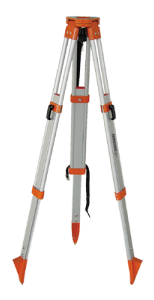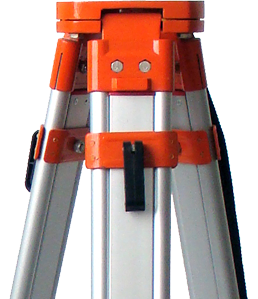How To Set Up A Tripod
What is a Tripod? How do Tripods for Laser Levels Work?

- Tripod Components
- How to Ready a Tripod
- How to Use a Light amplification by stimulated emission of radiation Level with a Tripod
- How to Use a Laser Level Detector
View tripods, detectors and laser accessories from Johnson Level.
A tripod is a three-legged stand, important in providing the foundation for laser levels and other leveling instruments such as: rotary laser levels, line laser levels, dot light amplification by stimulated emission of radiation levels, builder'southward levels, transit levels, automated levels and even sometimes torpedo laser levels. A tripod is typically used with a leveling instrument, course rod, laser pole and level detector. Tripods are portable and provide back up and stability forth both the side-to-side and up-and-downwardly axis of motion.
In that location are ii different kinds of tripods: adjustable-leg tripods and stock-still-leg tripods.
ane. Adjustable-Leg Tripods
Adjustable-leg tripods are the more mutual of the two in the construction world, especially outdoors because of generally uneven terrain. The adjustable-leg tripod is easier to fix on uneven basis because each leg can exist adjusted to exactly the height needed to find level, even on a very steep slope. The adjustable-leg tripod is also easy to transport due to having retractable legs.
2. Fixed-Leg Tripods
A fixed-leg tripod's legs remain the same length continuously. These tripods are being replaced more than by the adjustable-leg tripod.
Tripod Components
A tripod is made up of three Legs, each with metallic Points called shoes; and a Head, which the laser level or other leveling device attaches to.
Legs

The most common materials for tripod legs are:
- Steel
- Aluminum
- Fiberglass
- Forest
Steel is typically the most durable, all the same the heaviest pick. The lightweight and sturdy selection is aluminum. Wood or fiberglass legs are the near accurate materials used in making tripod legs because of their lack of sensitivity to changes in temperature.
Points
Each tripod, whether stock-still or adjustable, has metal points on the end of the legs for added stability and tin can help provide a stable environment for the leveling tools on top of the tripod. When working outdoors, points on the bottom of the tripod are essential, merely when working indoors, metal points can slide or scratch floors. Some tripods can be purchased with safety attachments which prevents either of these from happening.
Head
The head of the tripod is fastened to the legs and allows a steady surface to connect leveling devices. The tool y'all are using will dictate the blazon of tripod caput needed. For virtually light amplification by stimulated emission of radiation level applications, a flat head tripod with a bore of v/8 inch thread is used. If your laser level or other leveling musical instrument does not have a 5/8 inch thread, yous will need to purchase an adapter to convert it.
There are iii different kinds of heads:
- Flat Head
- Dome Head
- Threaded Base
Tripod Setup and Care
In lodge to properly use your tripod, you must:
- Verify the level, light amplification by stimulated emission of radiation level, or other instrument existence used will fit the tripod.
- Have the proper attachments available for the leveling device as well as the tripod (for case: a laser level detector or course rod)
- Make sure your tripod is make clean and in working status before attaching any instruments.
- When attaching laser levels or other leveling devices to tripods, make certain to cheque the screws and bolts are non too loose or likewise tight.
Worksite Weather
When choosing a tripod, worksite conditions are an important consideration. The surface the tripod will stand on determines how the tripod is set up so exist certain of the weather condition of the footing or surface where the tripod will be used.
- Adjustable-leg tripods are the only option for uneven terrain. In order to secure setting upward a tripod on a gradient, only ii of the three legs can exist downhill; the other must be placed up the hill. {Insert picture of tripod on slanted surface}
- If your tripod is existence prepare up on a surface such as finished concrete or tile, it is important to take a piece of non-slip material approximately five' x 5'.
- If you are setting your tripod up on a smoothen, flat surface, a triangular frame should be used to secure the legs. This frame should be made in the shape of an equilateral triangle with sides equaling 36".
- Surveyor'south hubs (blocks of wood used in marshy or frozen conditions) should be driven into the basis in the shape of an equilateral triangle if the ground is not stable.
How to Ready Up A Tripod
- When setting up your tripod, the legs should be pulled gently apart and spaced in the shape of an equilateral triangle.
- With the tripod legs spaced apart from each other, the points on each leg should be pushed into the ground to create a sturdy, stable support system for the tripod.
- When making sure the tripod is level, adjust the head to make a flat surface before attaching any sort of laser level or measuring tool.
- After the head of the tripod is level, it is of import to properly seat the legs. Never curve the legs.
- Push the legs into the footing gently at an angle.
- When using an adjustable-leg tripod, brand sure the legs are clamped at the appropriate height for the user.
How To Use a Laser Level with a Tripod
- Place the light amplification by stimulated emission of radiation level on the tripod.
- If y'all have an machine-level instrument, you don't have to calibrate it. A laser with auto-leveling is your most authentic method. If you need to do calibration yourself, apply the spirit tube and bubble, much like a traditional level.
- If you use the level in bright daylight, you lot won't be able to run into the light amplification by stimulated emission of radiation. Use the beep role to find the laser line. It will beep when you come in contact with the laser.
- Make marks where you demand them using the laser line you begin working. You'll need these marks for reference.
- Turn off the laser level when done.
How to Use a Laser Level Detector
- Turn on the laser level detector.
- Position the detector on the clamp holder using the screw on the holder itself.
- Put the clamp holder on the rod using the clench commodities on the holder.
- Aim the detector at the rotating laser.
- Loosen the clench bolt and move the detector upwards and down to receive the signal.
- Move the detector according to the direction indicated past the display.
- When the display indicates the signal is received directly, tighten the clench bolt.
- Use the measurement on the leveling rod from the ground as a reference for level in the area.
Caring for your Tripod
It is important to keep your tripod clean before and subsequently each time of use. Proper lubrication of the tripod joints is necessary to avoid article of clothing and tear. To keep them in good operating status, adjustable-leg tripods legs should be lubricated occasionally. A silicone-based lubricant works best because it does non collect dirt like a grease lubricant.
Transporting your Tripod
It is of import to protect your tripod when transporting it to, from and around the jobsite. Wrapping your tripod in a piece of heavy textile will provide your tripod with proper cushioning in a fall. It is important not to place other equipment on height of your tripod.
When transporting your tripod curt distances, it is not necessary to remove the level or other leveling devices from the head completely. For longer distances, brand sure the leveling device is safely disconnected from the tripod. Never carry your tripod over the shoulder; this could result in knocking the device into other equipment or other workers.
Storing your Tripod
When storing your tripod, it is of import to clean it properly. Storing your tripod without proper cleaning can event in challenges with equipment during its next employ. Tripods are all-time stored in corners or hanging from hooks. Leaning a tripod against a wall can lead to the equipment falling and beingness damaged. Protective caps should exist placed on the caput of the tripod to preclude damage when not in use.
For other informative how-to's, check out Johnson Level how-to's at their how-to guide page.
View tripods, detectors and laser accessories from Johnson Level.
Source: https://www.johnsonlevel.com/News/WhatisaTripodHowdoTripods

0 Response to "How To Set Up A Tripod"
Post a Comment